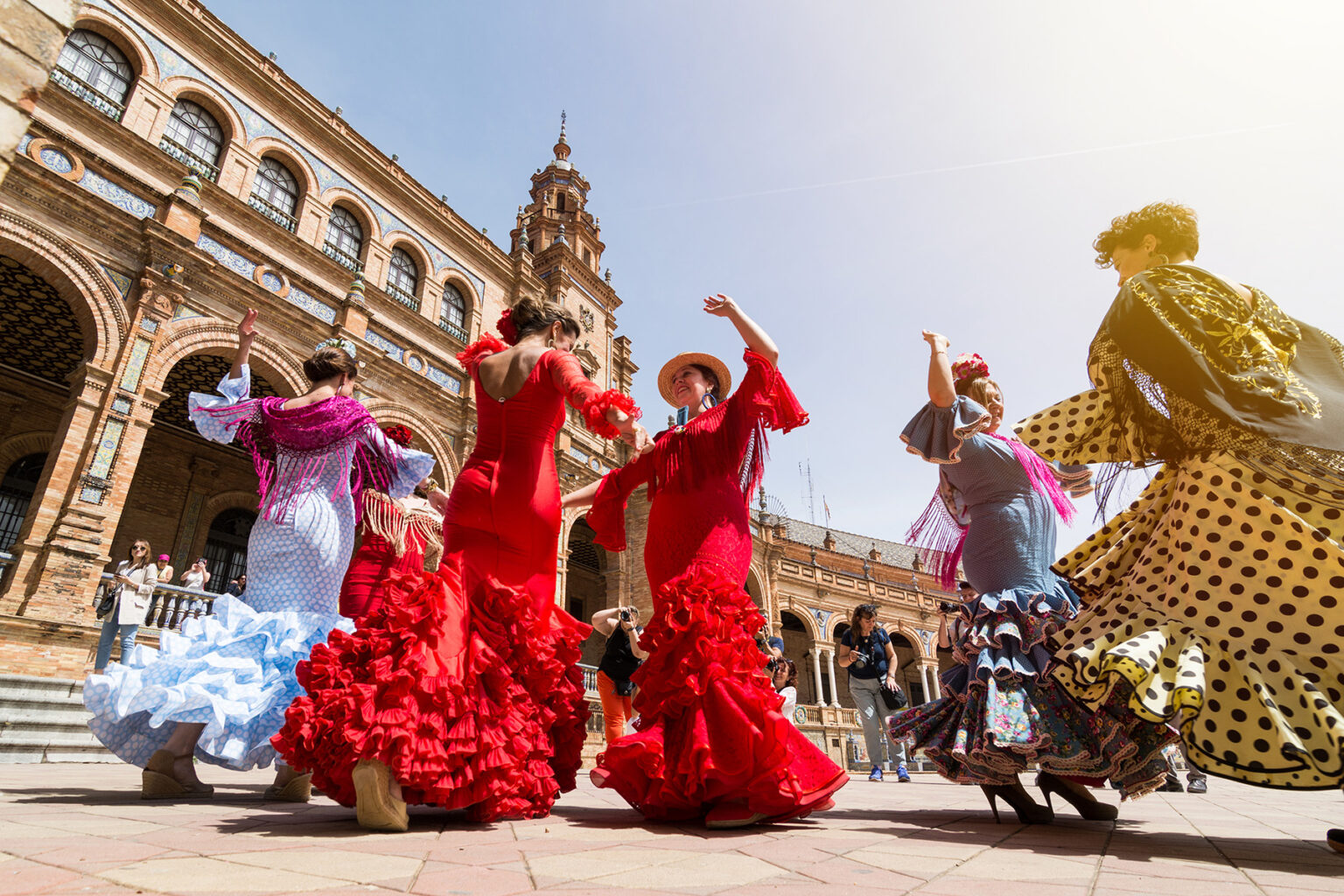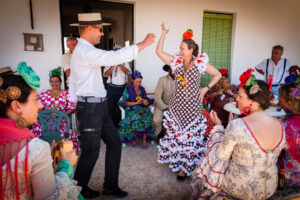Whether you call Spain home or are just passing through, attending festivals is a great way to immerse yourself in the country’s vibrant culture. And luckily, there are plenty of spectacular Spanish festivals to choose from.
Just pick a category and explore some of these weird and wonderful festivities throughout the country:
- Religious festivals in Spain
- Three Kings Day ( Fiesta de los Reyes) , nationwide
- All Saints’ Day ( Día de Todos los Santos ), Cádiz
- Holy Week ( Semana Santa ), Seville
- The Day of the Holy Innocents ( Día de los Santos Inocentes ), nationwide
- Fiesta de la Mercè , Barcelona
- Feast of St. James, ( Dia de Santiago ), Santiago de Compostela
- Cultural festivals in Spain
- Saint Sebastian Festival, ( Festes de Sant Sebastia ), San Sebastian
- Jarramplas Festival, Piornal, Cáceres
- The Arizkun Carnival (Jumping the Bonfire), Arizkun, Navarra
- Sitges Carnival, Catalonia
- Las Fallas Festival, Valencia
- Sant Jordi (Saint George) Festival, Barcelona
- Near Death Festival, Neves
- Festa Major de Gràcia, Catalonia
- Aste Nagusia, Bilbao
- La Tomatina, Buñol, west of Valencia
- Feria de Sevilla, Seville
- Fiesta de San Isidro, Madrid
- El Colacho (Baby Jumping) Festival, Castrillo de Murcia, near Burgos
- International Festival of Music and Dance, Granada
- Hispanic Day/Columbus Day, throughout Spain
- Food and drink events in Spain
- Film festivals in Spain
entradas.com
Discover the best in Spanish culture, sport, attractions, and more. Whatever your favorite entertainment looks like, entradas.com has tickets for all kinds of events on one handy platform. Whether it’s a family trip to the theme park or a solo wander around a museum, find your next big day (or night) out with entradas.com.
Religious festivals in Spain
Three Kings Day (Fiesta de los Reyes), nationwide
This famous religious festival is celebrated on 6 January and is considered to be Christmas day in Spanish culture. In anticipation of the arrival of the Three Kings, towns and cities across the country put on a spectacular parade on 5 January, which is known as the Cabalgata de los Reyes Magos. Musicians, dancers, and entertainment fill the streets while the Three Kings throw candy to children from their floats. The next day, families exhancge gifts and enjoy a big lunch together, as well as a traditional ring-shaped cake called the Roscón de Reyes, which represents the jewels of the crown and has a bean and a toy hidden inside.
All Saints’ Day (Día de Todos los Santos), Cádiz
All Saints’ Day is celebrated by the Roman Catholic and Protestant churches on 1 November. It is tradition to visit the graves of departed loved ones and place flowers or light candles on them. Although it is celebrated throughout the country, it is especially fun in Cádiz where celebrations are a little different. Here, it is known as Tosantos and the Gaditanos (locals of Cádiz) do wacky things like dress up rabbits and suckling pigs in the market, and make dolls out of fruit. The whole region gets involved and the festivities last all week.
Holy Week (Semana Santa), Seville
Semana Santa is one of the most important festivals on the Spanish holiday calendar. The Easter festivities take place all across Spain during the seven days leading up to Easter Sunday. However, the biggest spectacle is in Seville where a series of processions of elaborate floats bearing jeweled statues of Mary and Jesus take to the streets; alongside penitents wearing pointed hoods, and brass bands. Each year, the city is packed with visitors and locals, alike, but the experience is worth it.
The Day of the Holy Innocents (Día de los Santos Inocentes), nationwide
Every 28 December, the Spanish equivalent of April Fool’s Day gives people an excuse to do crazy things, such as playing practical jokes and telling spoof stories. During The Day of the Holy Innocents, it is also tradition to cut out white paper figures and pin them on the backs of unknowing victims who are called “innocents” – so beware! Ironically, the micheiveous tradition has a bit of a morbid backstory as it commemorates the killing of all children under the age of two by King Herod who attempted to kill the baby Jesus.
Fiesta de la Mercè, Barcelona
Every year, around the end of September, Barcelona hosts its largest street party, the Fiesta de la Merce in honor of the city’s patron saint, Our Lady of Mercy (La Mercè). Free music concerts take place in the plazas (particularly Plaça de Catalunya and Plaça Sant Jaume), and figures from folklore such as the gigants (giants) and cap grosses (fatheads) take to the streets. People come out to perform the sardana (the traditional Catalan dance) and to watch the nail-biting castellers (human towers). As night falls, firework displays light up the sky, culminating in an open-air performance by hair-raising correfoc; firework-brandishing devils and dragons.
Feast of St. James, (Dia de Santiago), Santiago de Compostela
The annual Feast of Saint James (Dia de Santiago) takes places every 25 July in Santiago de Compostela, and is a public holiday in Galicia. It commemorates the life and work of Saint James; the town’s patron saint who lies in the local cathedral. Theater productions, street shows, concerts, and dance events occur, together with religious services, during the festivities. Those walking the Camino de Santiago can also time their pilgrimage to end at this event.
Cultural festivals in Spain
Saint Sebastian Festival, (Festes de Sant Sebastia), San Sebastian
Every January, Spain’s northern city of San Sebastian comes alive with an explosion of bonfires and dancing in celebration of the patron saint of Mallorca, Saint Sebastian. For two weeks, visitors and locals alike enjoy cultural activities, sports events, and entertainment. In fact, the event is one of the highlights of the Spanish winter’s festivities, with barbecues taking place in Palma and the famous tamborrada drumming filling the air.
Jarramplas Festival, Piornal, Cáceres
Taking place every 19 and 20 January in the town of Piornal in the Cáceres province, the Jarramplas Festival involves pelting thousands of hard turnips at the devil-like characters (Jarramplas) to drive away evil spirits. During the festivities, several young men take turns dressing up in scary costumes of colorful fabric, a mask, green horns, and body armor underneath. Amazingly, portraying the Jarramplas is considered to be such an honor that there is a waiting list of some 20 years! While the exact origins of the festival are unknown, one popular theory is that the Jarramplas represents a cattle thief who was once punished by the locals.
The Arizkun Carnival (Jumping the Bonfire), Arizkun, Navarra
Every February, thousands of people queue up in the streets of Azizkun in Navarra to jump over some 20 bonfires, a tradition that dates back to pagan times. The jumps are believed to encourage fertility and ward off evil spirits. During the Arizkun Carnival, locals dress up in instantly recognizable costumes that look like sheepskin coats, adorned with black pots, wearing maypole-style hats, and carrying brushes. Needless to say, this daring challenge is not for the faint-hearted.
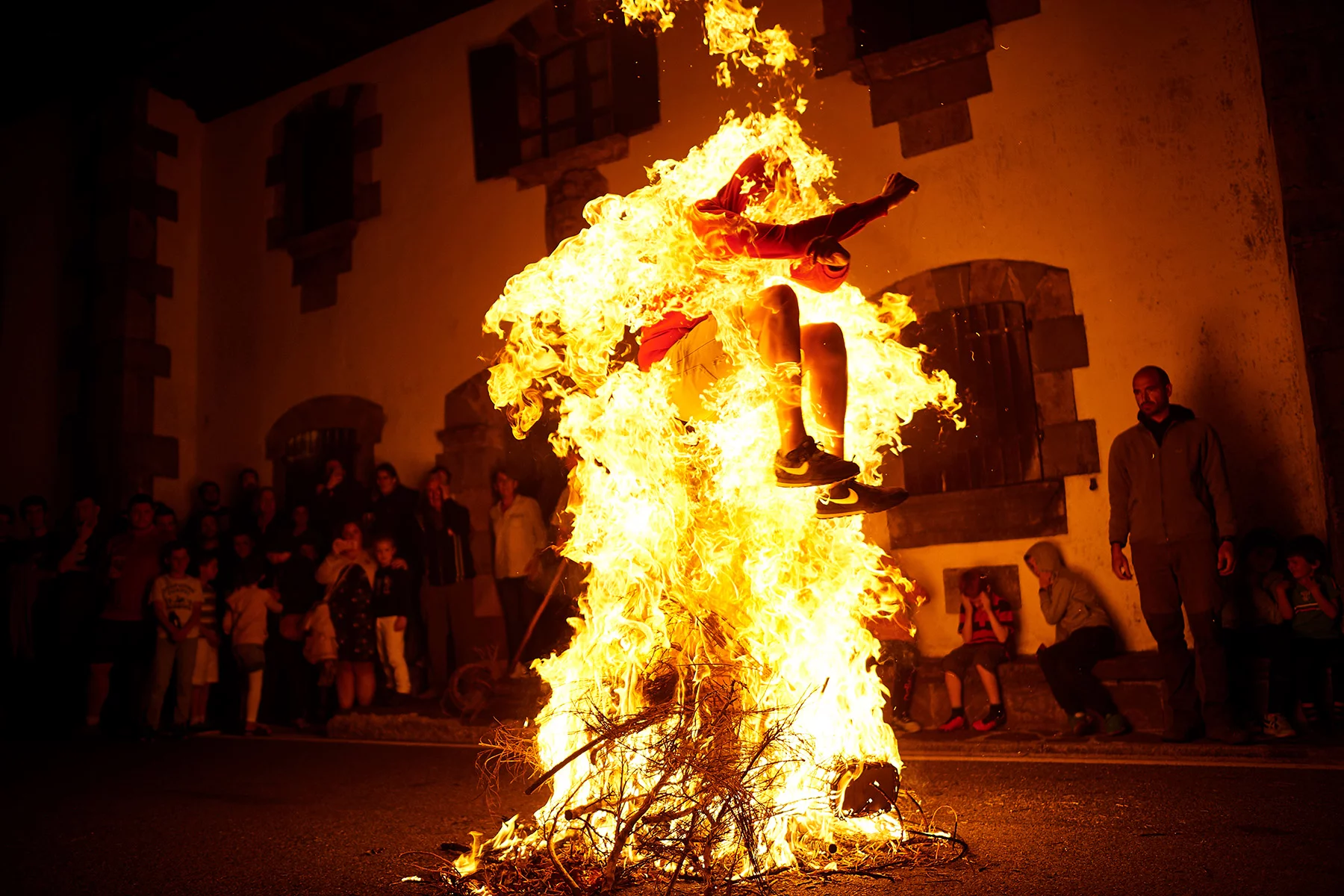
Sitges Carnival, Catalonia
Anything goes in the run-up to Lent in Spain’s most famous gay coastal vacation city, Sitges. The seven-day-long Sitges Carnival attracts more than 250,000 people who come to enjoy amazing parades, shows, and parties. There’s also a famous drag queen show and an enormous feast. The names of the two main parades – Extermination and Debauchery Parades – are a clue to the extravagance of the event, so make sure you dress up for the occasion. Conveniently, extra night buses and trains can get you to the event and back if you are staying in Barcelona.
Las Fallas Festival, Valencia
High-tech giant-size ninots (puppets or dolls) are shaped into traditional figures or even modern cultural icons such as Shrek and President Obama at the Las Fallas festival. The festival is actually on the UNESCO Cultural Heritage List since 2016. The creations are on display all over the city before locals light them in one of the many bonfires, which take place amid much partying. This year, more than 800 Fallas monuments will be bursting with humor and satire, fireworks, music, and tradition.
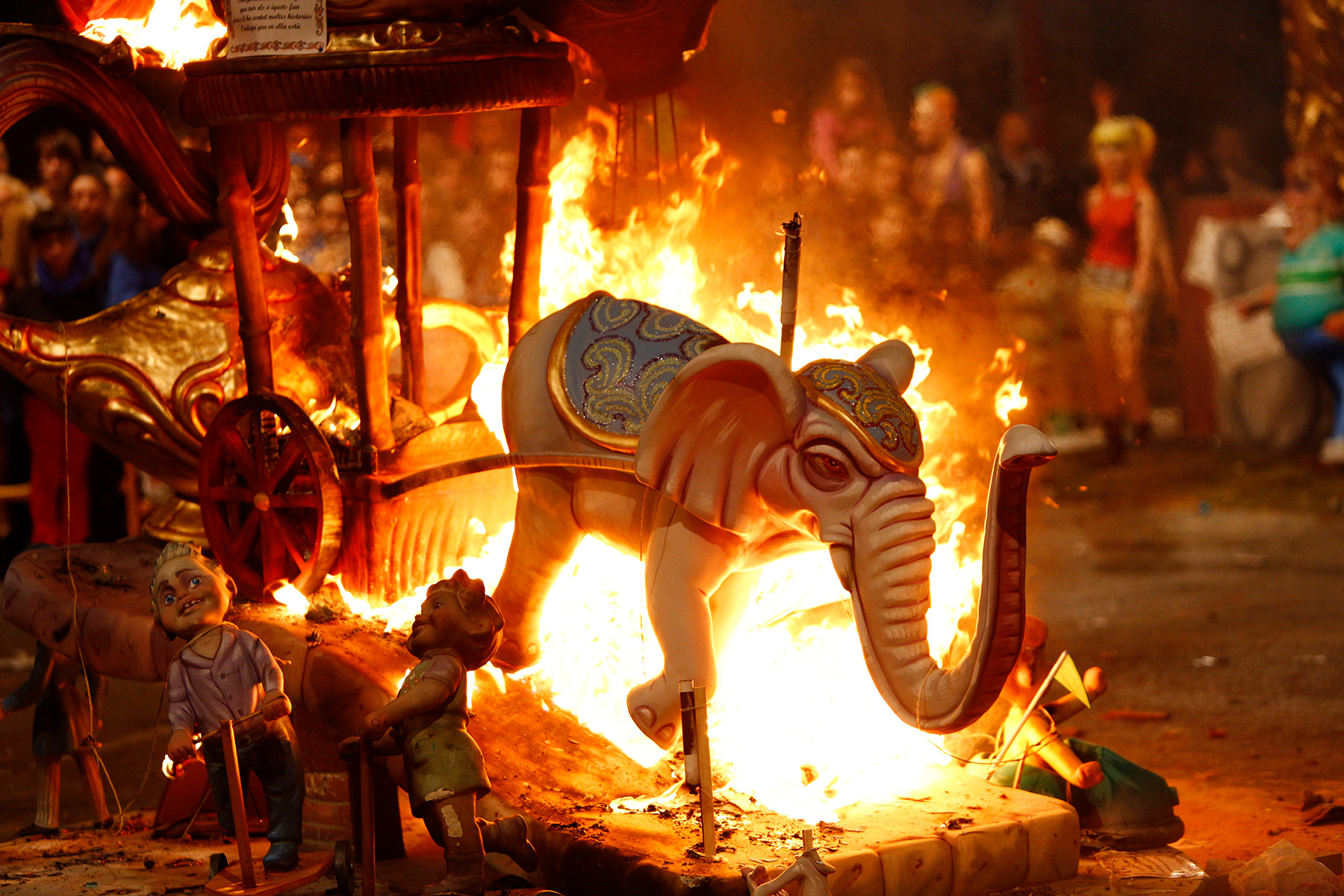
Sant Jordi (Saint George) Festival, Barcelona
Sant Jordi, or St George, is the patron saint of Catalonia. But St George’s Day in Barcelona is also the city’s version of Valentine’s Day when romance sweeps the city. The tradition is for the man to give his lady a rose in return for a book. The streets and balconies are clad in Catalonia’s red and yellow flag, the Senyera.
Near Death Festival, Neves
Those who have had a brush with death in the past year are carried through the streets in coffins to thank Saint Marta, the patron saint of death. Known in Spanish as Romería de Santa Marta de Ribarteme, this Near Death festival takes place in the small village Las Nieves, which borders Portugal.

Festa Major de Gràcia, Catalonia
All year long, the residents of Gràcia work on elaborate decorations with themes such as marine life, the solar system, or even local politics, to hang in the streets. By day, long trestle tables are set up for communal lunches as well as board games; at night, thousands invade the tiny streets for outdoor concerts, dances, and general revelry. The Gracia festival takes place outdoors in the hot, balmy weather in August.
Aste Nagusia, Bilbao
The Aste Nagusia, Semana Grande or Big Week, the Aste Nagusia festival in northern Spain, is held at the end of August when a rocket (txupinazo) shoots into the sky and the festival mascot Marijaia makes her appearance on a balcony of the Arriaga Theater. This nine-day festival celebrates Basque culture with live music and dancing; wood chopping, stone carrying, and strongman competitions; parades of giants; food and drink; bullfights; concerts; and nightly fireworks, culminating in the burning of Marijana.
La Tomatina, Buñol, west of Valencia
This is the world-renowned, tomato-flinging festival held on the last Wednesday of August. Thousands of joyful revelers use truckloads of overripe tomatoes as missiles. Only recently has the town started charging an entrance fee, so you’ll need a ticket to get in. Bring goggles and a change of clothes.
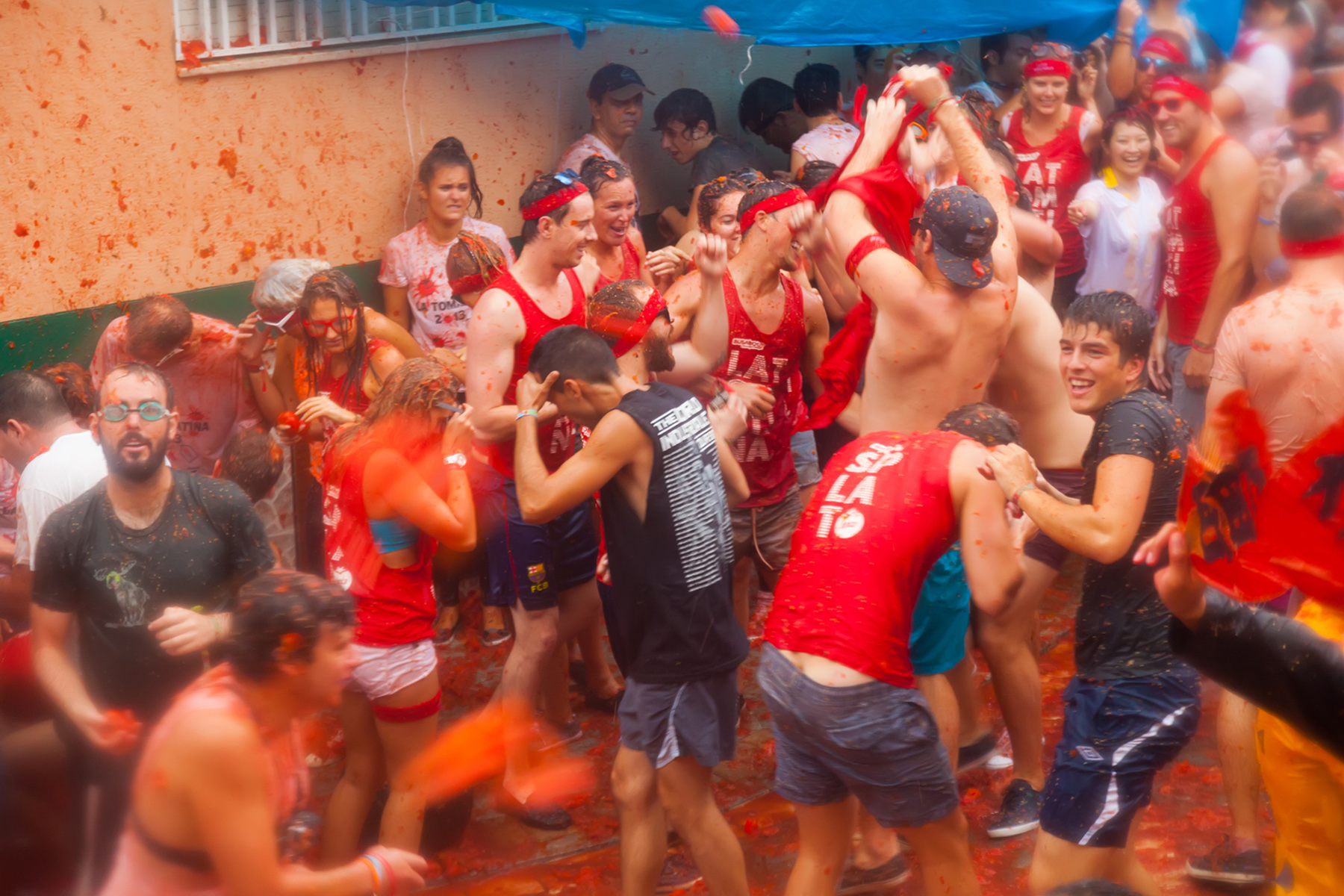
Feria de Sevilla, Seville
Spring Fair, the Feria de Abril de Sevilla, comes two weeks after Semana Santa. The Feria is a joyful festival with masses of Spanish food, drink, music, and dancing. Southwest of the city, there is a huge area is for the fair, creating a small town of casetas (tents or pavilions) for drinking, eating, and socializing. Most of the tents are private and invitation-only, but there are seven public ones, so you won’t miss out. Sevilliano/as, in traditional flamenco dresses, or tight trousers and boleros, parade around on horseback and in carriages – providing you with some fabulous photo opportunities.
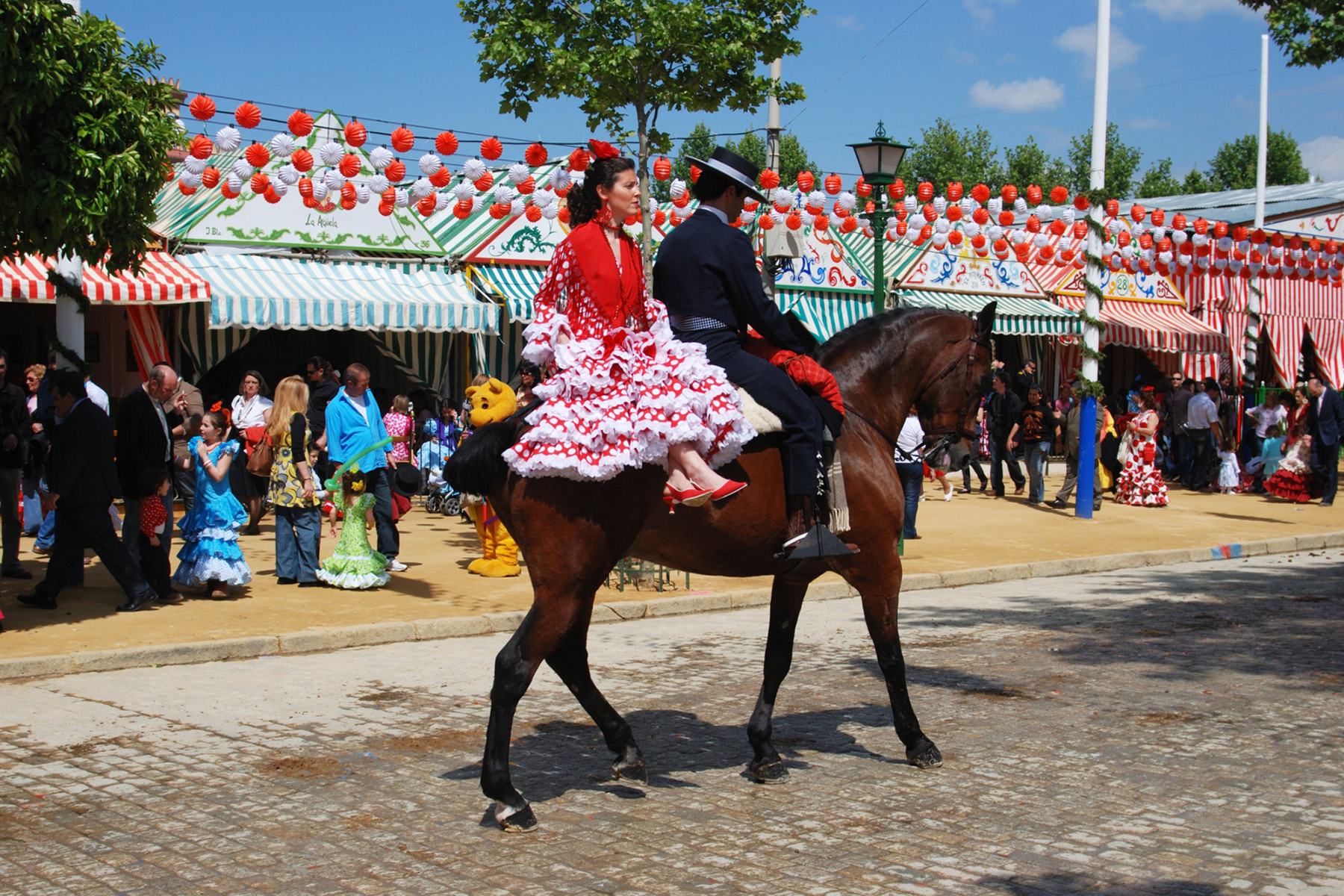
Fiesta de San Isidro, Madrid
It’s Madrid‘s largest festival. The events offer an opportunity to wear the traditional castizo finery and sample tasty delicacies such as thick, steamy broth. Music and dancing are everywhere with flamenco, zarzuelas, and Latin rhythms happening at concerts all over the city. The San Isidro Festival starts with a grand procession of giants and cabezudos, with an opening speech in the Plaza Mayor afterward. Over the next few days, entertainment and revelry take over the city’s public spaces.
El Colacho (Baby Jumping) Festival, Castrillo de Murcia, near Burgos
The Spanish El Colacho festival sees townspeople dress up in colorful costumes. They form a queue to leap over a mattress laden with babies born during the previous year. The ceremony rids the babies of evil spirits and guards them against illness. This is one of the Corpus Christi festivals in Spain on the first Sunday after Corpus Christi.
International Festival of Music and Dance, Granada
This Spanish festival is a celebration of flamenco and classical music that traces its origins back to the 1880s. It combines the vibrant energy of Spanish guitars, castanets, and flamenco dancers. It has also become widely known for the impressive performance venues and for the presence of the most outstanding performers of the day. Each year, outstanding young artists, musicians, and dancers include in their projects top professionals who are prepared to back interesting new projects.
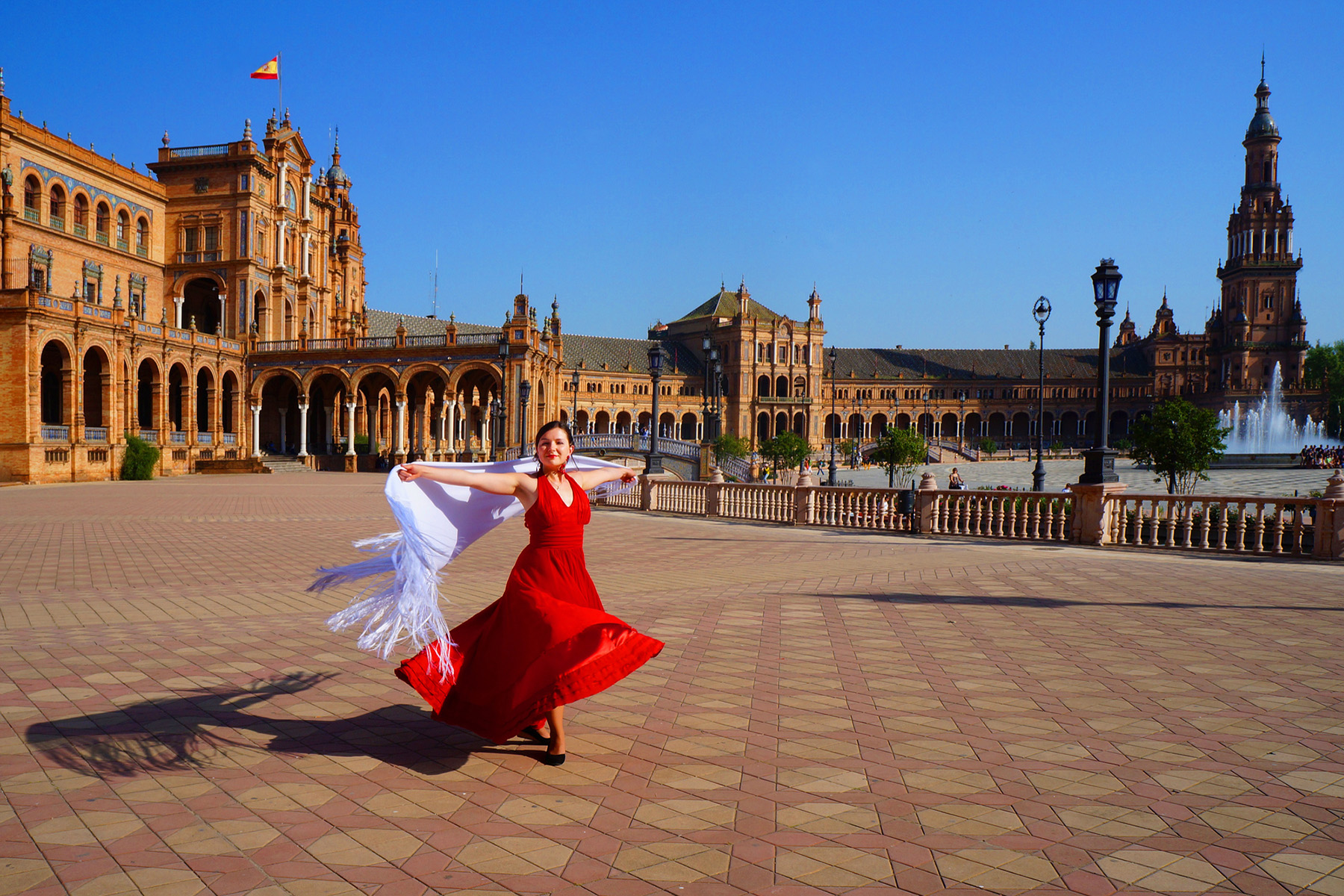
Hispanic Day/Columbus Day, throughout Spain
El Día de la Hispanidad is a national holiday of Spain that is celebrated on 12 October, commemorating when Christopher Columbus set foot in the Americas. A special parade happens at La Plaza de Colon in Madrid, led by the military and the Spanish royal family. A wide array of other authorities, from foreign diplomats as well as the presidents of the autonomous governments, attend this parade. The Spanish armed forces also fly through the air doing aerobatics with red and yellow smoke drawing images for the crowd to see.
Food and drink events in Spain
Feria de la Manzanilla in Sanlucar de Barrameda
If you like your sherry, this Sanlucar de Barrameda festival (only in Spanish) should be right up your street. The locals celebrate their local drink by consuming unhealthy quantities of it, along with plenty of fish and tasty tapas. The week officially begins when the lights turn on, but festivities usually start early the previous weekend. On Sunday, there is a spectacular firework display to end the festival with a bang.
Haro Wine Festival
There are celebrations all over Spain to mark the Spanish wine harvest. One of the best is in Haro in La Rioja region. La Batalla de Vino, or the Wine Fight, starts with a huge street party on the eve of 29 June. The next day, the locals climb up a nearby mountain and drench each other with rioja using sprays, buckets, water pistols, or whatever they can lay their hands on. The battle then moves down the mountain and into the town where dancing and general merrymaking continues, all accompanied by the quaffing of lots and lots of vino tinto. Wear old clothes!
San Andres Festival, Puerto de la Cruz, Tenerife
In theory, the San Andres festival is about tasting the new year’s wine, but it’s usually more about making a lot of noise in the streets with pots, pans, and assorted objects. Celebrants drag cans and other noisy metal objects tied to string and wire through the streets of the town, and everyone drinks into the early hours.
Film festivals in Spain
CutreCon Film Festival, Madrid
Films that are so bad that they’re actually good are the cornerstone of this festival. This five-day Cutrecon film festival (only in Spanish) held in Madrid celebrates bad acting, terrible scripts, and tragic directing. This festival attracts several thousand visitors.
International Animation Festival, Lleida, Catalonia
The Animac Mostra Internacional de Cinema d’Animació de Catalunya is a ANIMAC film exhibition open to makers of animated films using a variety of techniques. Takes place over four days with projections, conferences, workshops, and other special activities in the usual headquarters of the festival, La Llotja, CaixaForum Lleida.
San Sebastián International Film Festival
The premier film festival of Spain takes place in the Basque capital in September, across several different theaters. Retrospectives are frequently featured, and week-long screenings are also held.
Annual Horror and Fantasy Film Festival, San Sebastian
Various venues show a range of horror movies during this Horror and Fantasy Film Festival. Together with outdoor performances and street theater, comedy events, horror-related exhibitions, and many fanzine festivities.
